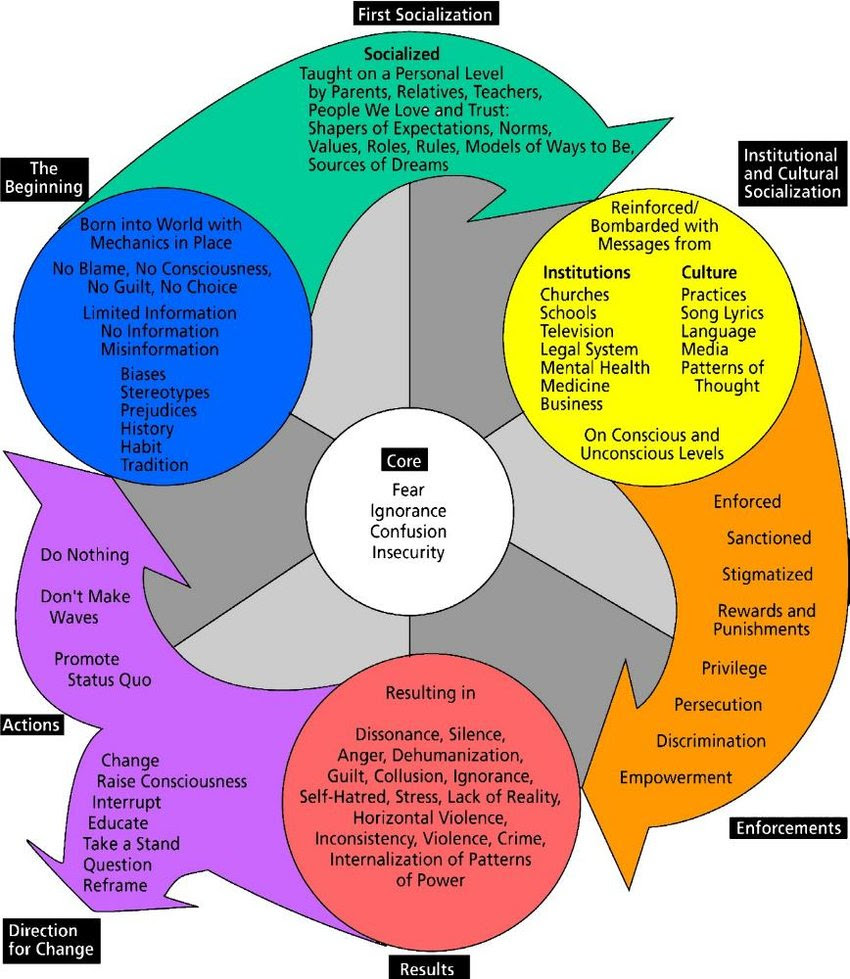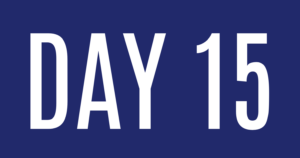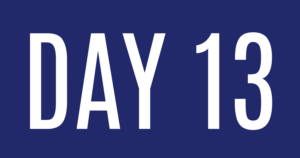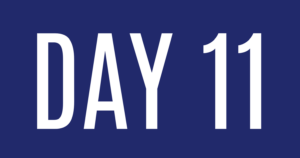
[Overall large blue rectangle with bold text on the left that reads: “21-Day Racial Equity Challenge”, with the United Way of South Central Michigan logo above. At right are colorful interconnecting shapes.]
Racial Socialization
Socialization is a process we all go through – it’s how we develop values, habits, and attitudes and learn to understand and move through the world. Understanding the process of socialization can help us understand how we came into our views of race and racism as well as what we can do to create communities and a society that work for all of us, not just some of us.
In 1997, Dr. Bobbie Harro offered a way of understanding how we learn about social identities in a concept she titled The Cycle of Socialization.
It describes the following:
- In the beginning, we’re born into the world without any assumptions or ideas in place. There’s no blame, no consciousness, no guilt, nor choice, and we have limited information.
- We then experience socialization, where people teach us on a personal level. These teachers may include parents, relatives, teachers, people we love and trust who share expectations, norms, values, roles, rules, models of ways to be, and sources of dreams.
- These messages we learn on a personal level, we are then taught to use through institutional and cultural socialization. We learn through messages from institutions like churches, schools, TV, and more as well as through culture-like practices, song lyrics, language, media, and patterns of thought. This happens on a conscious and unconscious level.
- These concepts are enforced through a number of ways like stigma, reward and punishments, discrimination, and empowerment.
- And this results in a variety of responses including dissonance, dehumanization, guilt, violence, and internalized patterns of power.
- At the center of socialization are the core tools of fear, ignorance, confusion, and insecurity that allow the cycle to continue.
Harro offers that the cycle can be allowed to continue if nothing is done, no one makes waves, and we choose to promote the status quo. Or there can be an intentional change in direction. We can do this by interrupting, educating ourselves and each other, asking questions, and more.

(Source: Harro’s (1997) Cycle of Socialization | Download Scientific Diagram)
[Colorful, circular diagram that describes the Cycle of Socialzation from “The Beginning” to “Action”.]
So what? Fortunately, Harro also offers a model for The Cycle of Liberation. Key considerations include building community and taking action for change. Want to learn more? Check out this short and digestible video by The Culture of Respect.
Today’s Challenge
Read
- Take a look at this website to explore Defining Racial and Ethnic Socialization. (2+ minutes) https://www.apa.org/res/about/racial-ethnic-socialization
Watch
- Watch this short video on the culture cycle to see how we “do” race across different levels. (4 minutes) https://www.youtube.com/watch?v=oXybxTn8YhI&feature=emb_logo
Listen
- Listen to some of the stories on the EmbraceRace website that speak to how racial socialization shapes our individual and collective lives. (2+ minutes)
https://www.embracerace.org/resources/stories
Engage
- Review Harro’s Cycle of Socialization. What was your racial socialization journey?
- Review Harro’s Cycle of Liberation. What are your “waking up” moments that have made you want to learn more about the impacts of race and racism? What steps do you hope to take in the cycle that will support where you want to go?
Discuss
- What are some of the risks of “interrupting,” or stepping away from the cycle of socialization? What are some of the benefits?
What are some everyday actions that you can take to interrupt the cycle of socialization? What are steps you can take to enter the cycle of liberation?

Thank you to our sponsor, Peckham, for making this challenge possible!










